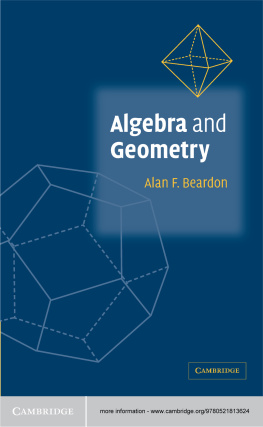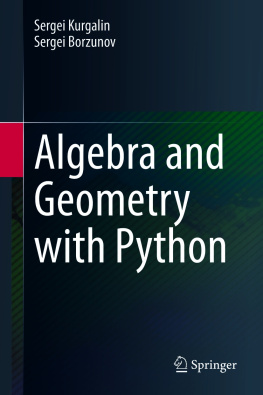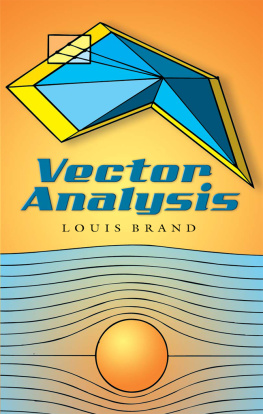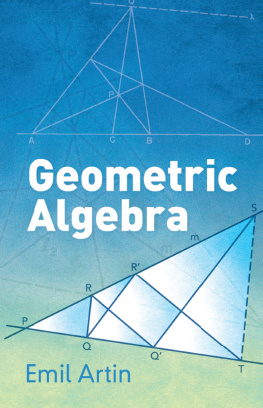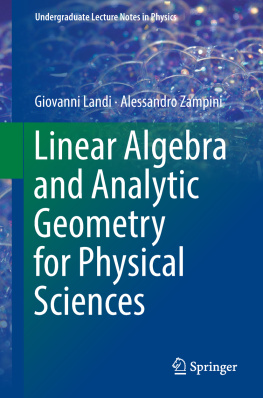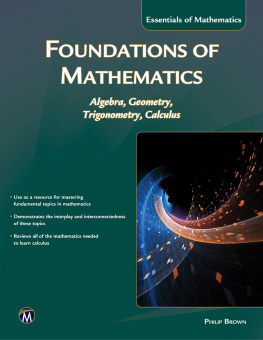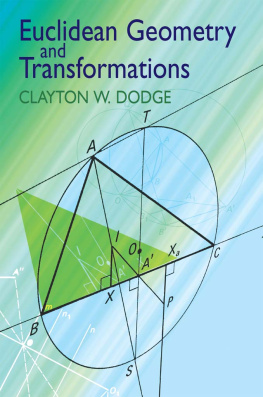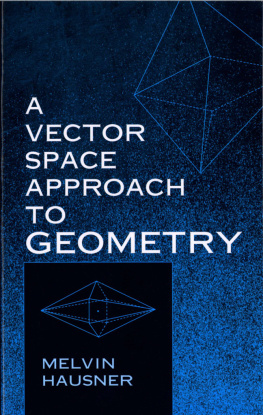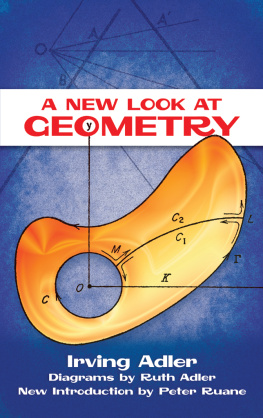ALGEBRA AND GEOMETRY
This text gives a basic introduction and a unified approach to algebra and geometry. It covers the ideas of complex numbers, scalar and vector products, determinants, linear algebra, group theory, permutation groups, symmetry groups and various aspects of geometry including groups of isometries, rotations and spherical geometry. The emphasis is always on the interaction between these topics, and each one is constantly illustrated by using it to describe and discuss the others. Many of the ideas are developed gradually throughout the book. For example, the definition of a group is given in so that it can be used in a discussion of the arithmetic of real and complex numbers; however, many of the properties of groups are given later, and at a time when the importance of the concept has become clear. The text is divided into short sections, with exercises at the end of each one.
ALGEBRA AND GEOMETRY
ALAN F. BEARDON

CAMBRIDGE UNIVERSITY PRESS
Cambridge, New York, Melbourne, Madrid, Cape Town, Singapore, So Paulo, Delhi, Dubai, Tokyo
Cambridge University Press
The Edinburgh Building, Cambridge CB2 8RU, UK
Published in the United States of America by Cambridge University Press, New York
www.cambridge.org
Information on this title: www.cambridge.org/9780521813624
Cambridge University Press 2005
This publication is in copyright. Subject to statutory exception and to the provisions of relevant collective licensing agreements, no reproduction of any part may take place without the written permission of Cambridge University Press.
First published 2005
Fourth printing 2010
Printed in the United Kingdom at the University Press, Cambridge
A catalogue record for this publication is available from the British Library
Library of Congress Cataloguing in Publication data
ISBN 978-0-521-81362-4 hardback
ISBN 978-0-521-89049-6 paperback
Cambridge University Press has no responsibility for the persistence or accuracy of URLs for external or third-party internet websites referred to in this publication, and does not guarantee that any content on such websites is, or will remain, accurate or appropriate. Information regarding prices, travel timetables and other factual information given in this work are correct at the time of first printing but Cambridge University Press does not guarantee the accuracy of such information thereafter.
To Dylan, Harry, Fionn and Fenella
Contents
Preface
Nothing can permanently please, which does not contain in itself the reason why it is so, and not otherwise
S.T. Coleridge, 17721834
The idea for this text came after I had given a lecture to undergraduates on the symmetry groups of regular solids. It is a beautiful subject, so why was I unhappy with the outcome? I had covered the subject in a more or less standard way, but as I came away I became aware that I had assumed Eulers theorem on polyhedra, I had assumed that every symmetry of a polyhedron extended to an isometry of space, and that such an isometry was necessarily a rotation or a reflection (again due to Euler), and finally, I had not given any convincing reason why such polyhedra did actually exist. Surely these ideas are at least as important (or perhaps more so) than the mere identification of the symmetry groups of the polyhedra?
The primary aim of this text is to present many of the ideas and results that are typically given in a university course in mathematics in a way that emphasizes the coherence and mutual interaction within the subject as a whole. We believe that by taking this approach, students will be able to support the parts of the subject that they find most difficult with ideas that they can grasp, and that the unity of the subject will lead to a better understanding of mathematics as a whole. Inevitably, this approach will not take the reader as far down any particular road as a single course in, say, group theory might, but we believe that this is the right approach for a student who is beginning a university course in mathematics. Increasingly, students will be taking more and more courses outside mathematics, and the pressure to include a wide spread of mathematics within a limited time scale will increase. We believe that the route advocated above will, in addition to being educationally desirable, help solve this problem.
To illustrate our approach, consider once again the symmetries of the five (regular) Platonic solids. These symmetries may be viewed as examples of permutations (acting on the vertices, or the faces, or even on the diagonals) of the solid, but they can also be viewed as finite groups of rotations of Euclidean 3-space. This latter point of view suggests that the discussion should lead into, or away from, a discussion of the nature of isometries of 3-space, for this is fundamental to the very definition of the symmetry groups. From a different point of view, probably the easiest way to identify the Platonic solids is by means of Eulers formula for the sphere. Now Eulers formula can be (and here is) proved by means of spherical geometry and trigonometry, and the requisite formulae here are simple (and important) applications of the standard scalar and vector product of the usual vectors in 3-space (as studied in applied mathematics). Next, by studying rotation groups acting on the unit sphere in 3-space one can prove that the symmetry groups of the regular solids are the only finite groups of rotations of 3-space, a fact that it not immediately apparent from the geometry. Finally, by using stereographic projection (as appears in any complex analysis course that acknowledges the point at infinity) the symmetry groups of the regular solids appear as the only finite groups of Mbius transformations acting in hyperbolic space. Moreover in this guise one can also introduce rotations of 3-space in terms of quaternions which then appear as 2-by-2 complex matrices.
The author firmly believes that this is the way mathematics should be introduced, and moreover that it can be so introduced at a reasonably elementary level. In many cases, students find mathematics difficult because they fail to grasp the initial concepts properly, and in this approach preference is given to understanding and reinforcing these basic concepts from a variety of different points of view rather than moving on in the traditional way to provide yet more theorems that the student has to try to cope with from a sometimes uncertain base.
This text includes the basic definitions, and some early results, on, for example, groups, vector spaces, quaternions, eigenvectors, the diagonalization of matrices, orthogonal groups, isometries of the complex plane and of Euclidean space, scalar and vector products in 3-space, Euclidean, spherical and (briefly) hyperbolic geometries, complex numbers and Mbius transformations. Above all, it is these basic concepts and their mutual interaction which is the main theme of this text.
Finally an earlier version of this book can be freely downloaded as an html file from http://www.cambridge.org/0521890497 . This file is under development and the aim is to create a fully linked electronic textbook.
Groups and permutations
1.1 Introduction
This text is about the interaction between algebra and geometry, and central to this interaction is the idea of a group. Groups are studied as abstract systems in algebra; they help us to describe the arithmetic structure of the real and complex numbers, and modular arithmetic, and they provide a framework for a discussion of permutations of an arbitrary set. Groups also arise naturally in geometry; for example, as the set of translations of the plane, the rotations of the plane about the origin, the symmetries of a cube, and the set of all functions of the plane into itself that preserve distance. We shall see that geometry provides many other interesting examples of groups and, in return, group theory provides a language and a number of fundamental ideas which can be used to give a precise description of geometry. In 1872 Felix Klein proposed his
Next page
